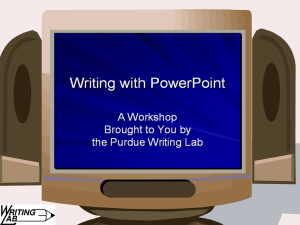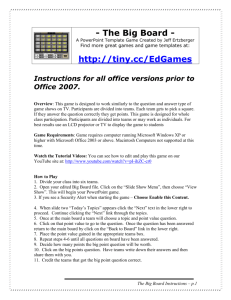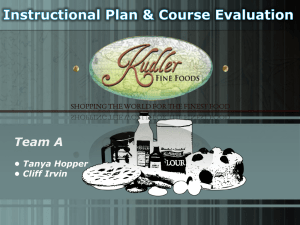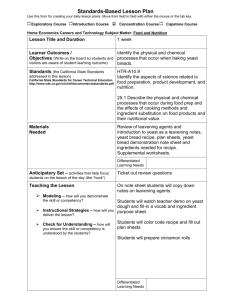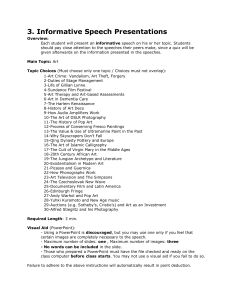Yeast
advertisement
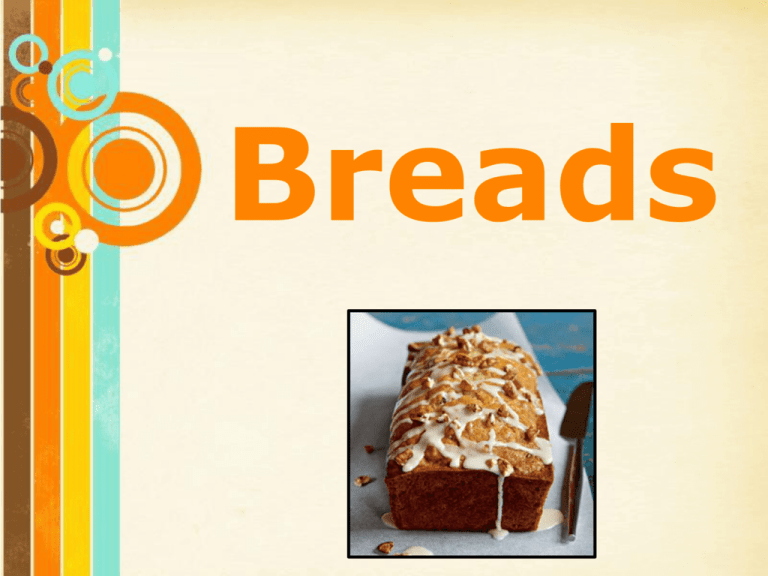
Breads Free Powerpoint Templates Page 1 Two Basic Forms of Baked Goods • Quick Breads • Yeast Breads • They are fast or “quick” • They take longer to make (less than an hour to bake) and bake • They use baking soda or • They use yeast for leavening powder for leavening • Requires kneading to • They do NOT need to rise or develop gluten Free Powerpoint Templates proof • They need to rise or proof Page 2 Quick Bread The basic ingredients and their purposes in quick bread are: Body/Structure • Flour: • Leavening Makes the quick bread rise (Baking powder/baking soda) Agents: Flavor • Salt: Browning/Flavor • Sugar: Tenderness/Richness • Fat: Moisture • Liquid: Free Powerpoint Templates Page 3 Yeast Bread The basic ingredients and their purposes in yeast bread are: • Flour: Body/Structure • Yeast: Provides Leavening Controls Yeast • Salt: • Sugar: Feeds Yeast Tenderness • Fat: • Liquid: Dissolves and activates yeast Color, texture and nutrients • Egg: Free Powerpoint Templates Page 4 Leavening Agents • Leavening agents are substances used in batters and doughs that cause them to rise or expand, usually because CO2 is produced. • Common leavening agents include yeast, baking powder, baking soda, air Free Powerpoint Templates and eggs. Page 5 Yeast • The liquid used to activate the yeast should be between 115°F-125°F. – If the water is too hot, it will kill the yeast. – If the water is too cold, the yeast will not activate. • Sugar helps feed the yeast and salt controls the growth of the yeast. • Yeast breads require time to proof or rise. This is called Free Powerpoint Templates “proofing.” Page 6 Baking Soda/Powder • These leavening agents require an acid in order to react or produce CO2. • Baking soda must have an acid from an outside source like vinegar, honey or lemon juice. • Baking powder already has a powdered acidic agent mixed in with it. All it needs is moisture to react. • These leavening agents produce a fast or “quick” reaction so the food product that uses them must be baked quickly. Free Powerpoint Templates Page 7 Common Acids Used In Food to Produce Leavening • • • • • • • Sour Cream Sour Milk (Buttermilk) Vinegar Cream of Tartar Honey Molasses Lemon Free Juice Powerpoint Templates Page 8 Gluten and Kneading Gluten: when water is mixed with flour, the proteins in the flour give strength and elasticity to batters and doughs. This is usually done by stirring or kneading. Kneading: to work a dough with the palms of the hands to develop gluten. Free Powerpoint Templates Page 9 Types of Quick Breads • Dough *Requires Kneading – Biscuits – Scones – Doughnuts • Batter *Requires Stirring – Waffles – Pancakes – Muffins Free Powerpoint Templates Page 10 Muffin Method 1. Combine all dry ingredients together into a bowl. 2. In a separate bowl, blend all of the liquid ingredients together, (including fat). 3. Make a well in your dry ingredient bowl and pour the liquid in the well. 4. Stir until dry ingredients are Free Powerpoint Templates Page 11 moistened. Muffin Method Free Powerpoint Templates Page 12 Muffin Method • The Perfect Muffin: 1. Will have a cauliflower top 2. Will have some, but few, tunnels in the interior. 3. Will be tender. • The Under-Mixed Muffin: 1. Will have low volume. 2. Will have a flat surface. 3. Will be very crumbly. • The Over-Mixed Muffin: 1. Will have a peaked top. 2. Will be very tough. 3. Will have large tunnels in the interior. Free Powerpoint Templates Page 13 Free Powerpoint Templates Page 14 Biscuit Method 1. Combine all dry ingredients. 2. Cut-in the fat until there are crumbs. 3. Add the liquid and stir until a dough forms. 4. Knead the dough so gluten will form. 5. Roll out the dough and cut into biscuits with biscuit cutter. 6. Place on a greased cookie sheet. Free Powerpoint Templates Page 15 Biscuit Method • The Perfect Biscuit: 1. Will have a flat top. 2. Will have straight sides. 3. Will be flaky with layers. Free Powerpoint Templates Page 16 Most important steps in biscuit making: 1. Cutting-In the Fat (To Create the Layers) 2. Kneading (To Develop Gluten) Free Powerpoint Templates Page 17 Free Powerpoint Templates Page 18

